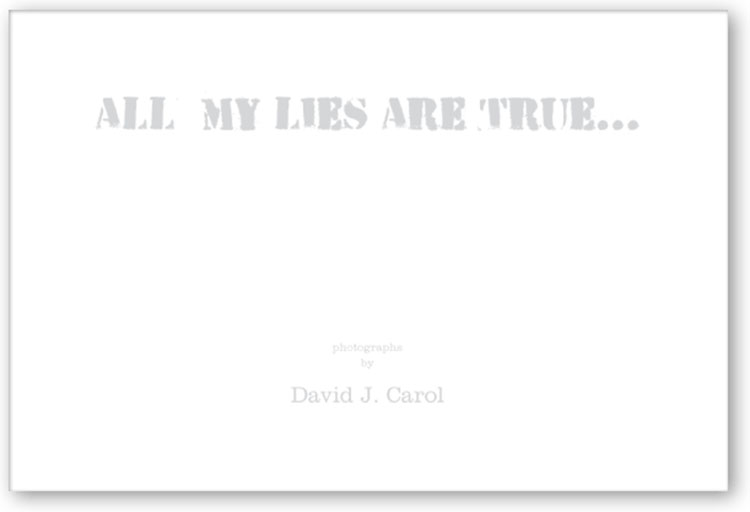
Copyright David Carol 2009, courtesy of David Carol
Inside the window is a beautiful wedding dress, but this simple window is framed by a neutral toned cinderblock and wood wall with an exposed adjacent electrical box. The surrounding ground is a patchwork of grass and dirt, with a barren tree lurking on the edges of the fame. This bleak looking scene is not enhanced by the mirrored reflection of an oil well rig ringed by an overcast sky. The wedding dressed manikin is facing inward, with the reflected oil rig positioned such that it is just above the back shoulder out of the field of vision. This is a dark story about love and romance with a fairy tale wedding story, but looming in the background is the reality of a rough and tumble working life working out in the plains. This same mixture of humor and pathos seems to run though David Carol’s photobook All My Lies Are True.
The book’s title takes umbrage with the supposedly documentary aspect of photography that although a photograph appears to be factual and true, that the underlying essence of any photograph is that it exits as a unique fabrication by the photographer. All photographs are lies. Carol is stating that this is not the case with his photographs, he has in fact documented truth, or at least he would like us to believe as much. It is that contradictory thread running through this body of work which makes Carol’s humor and pathos that much more complex.
The coarse and grainy contrast of his black and white photographs provides a gritty undertone to these images and heightens for me a feeling of pathos. All of the photographs have a horizontal framing, outlined with a distinct black border to ensure separation from the nice white margins. This layout design seems to work well to maximize the size of the images within this horizontal book. Ironically, the black border was an early photographic technique to ensure that a photograph would be seen as a two-dimensional image and not be confused with reality.
In combination with the accompanying captions, it is obvious to me that Carol is a punster, humorous and witty, perhaps like Elliott Erwitt, seeing the absurd in the everyday, who mined the urban landscape with his series of flicks, snaps and photofictions. Perhaps not as dire as the work by Barbara Kruger, who Carol Squiers states, “Although Kruger’s work is always levered by and sometimes dependent on humor for its punch, it is usually humor of the blackly corrosive variety”.
I have found myself challenged by Carol’s photographs, attempting to find the comedy, satire, irony or humor before I advance the page, although not always successfully. I remember a quote about a comedian, regretfully whose name I do not recall, who stated that “humor is really hard work”. Sometimes humor is witty and ironic, leaving you smiling, enjoying the delightful pun that has been discovered, but sometimes it leaves the comedian sweating. It seems that a small number of Carol’ photographs are highly dependent on the accompanying caption for their success.
Humor also depends on your cultural background, life-stories and past memories, thus some will have an easier time with some of Carol’s photographs than others. I recall when my wife and I were rolling with laughter at a Robyn Williams comedy in a Munich theater, unlike everyone else (later my wife said that those around me were only laughing after I began laughing). We understood the subtly of the puns and jokes because we grew up in the United States. The movie had a subtext and external context that was not easily understood without that cultural grounding.
Carol placed the sign of the sailing shipping floating on a far wall, made all that more humorous if noted that this was photographed in Mystic, Maine. A wiry spelled out HAPPY sign is in fact falling over and neither appears very uplifting or in a very happy state. A Welcome sign obliterated by the growing shrub, implies that in fact you are not really welcome at all. A dour looking white-face clown stands facing the photographer with the ironic text We Ha Fun Yet written on his shirt. At an apparent sales lot, multiple OK signs are festooned on the abandoned and rundown property. A pair of doors on the side of a building, with a number 3 on both doors and a giant spray-painted 3 and arrow pointing to the same doors, belabors the obvious.
There is a Walker Evans element to a photograph of billboard poster that has been composed to extract the paired text of Alive with Pleasure in juxtaposition with Cancer, Heart Disease & Emphysema, then within the in the lower corner of the frame, a smiling face is reflected on the windshield of the car. A heart shaped clock is also adorned with the text Free Tibet. Three plumb paper covered figurines are hanging in the foreground, then subtly in the background on the edge is a cartoon of a laughing chef who appears to be very amused by this sight.
Carol finds humorous and absurd situations of the everyday, utilizing an amusing vernacular to highlight poignant ironies. At times overstating the obvious, other times with an undercurrent of satire and black humor, he captures mankind’s follies in comedic relief. Regretfully, Comedies rarely get an Academy Award, but that does not make them any less popular, entertaining and enjoyable.
By Douglas Stockdale






No comments:
Post a Comment